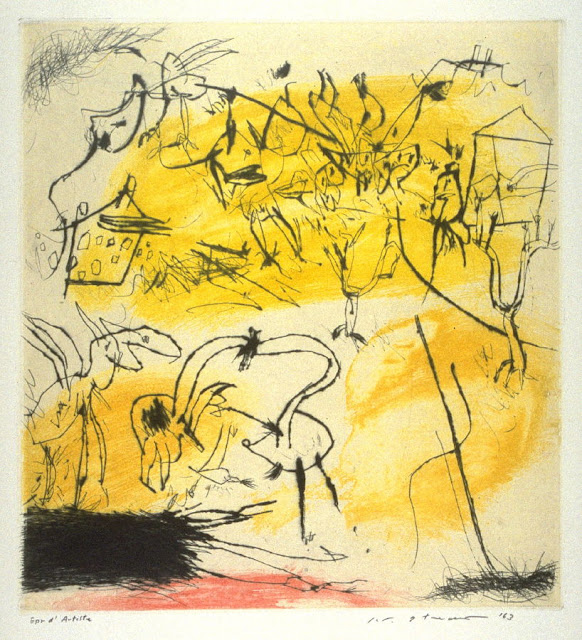"Masuo Ikeda, printmaker, painter, author, ceramist, and painter, was born Mukden, China on February 23, 1934. He started off life on the wrong foot, by being born abroad, in Mukden, China (now known as Shenyang). After the Second World War he was repatriated with his parents to Nagano prefecture. Attending school in Japan is always a traumatic experience for children who have lived abroad and known more liberal standards of education. Masuo refused to fit in. Disdaining standardized syllabuses he plunged into the delights of foreign literature - Stendhal, Salinger, Sartre, Kafka, Camus, the Surrealists. It was no wonder he twice failed the stiff entrance examinations for Tokyo Geidai (the Tokyo University of the Arts). So he set to teaching himself how to draw and paint, then began attending the Nagano School of Art, from which he managed to graduate in 1952.
Ikeda had been painting in oils, so he followed Graumann's advice, realizing that it was a better business proposition to make prints, because he could sell many copies, whereas there was only one buyer for a painting. He also tried traditional woodblock printing (ukiyo-e or "images of this floating world") and serigraphy (silk screen) techniques. Young Japanese artists were beginning to travel abroad again to Paris, London and New York, where Stanley Hayter was a great inspiration, for he had started with dry point, aquatint, and woodblock prints but had gone on to develop new processes. In London, the Swedish printmaker Birgit Skiold's studio in Charlotte Street was always full of young Japanese attracted by her refined photo-etching experiments and their links to poetry, for Japan is a land where literature and printing inhabit the same scrolls.
In 1976, Ikeda again stepped out of his category and published his first work of fiction, Eige-kai ni sasaguru (Homage to the Aegean). It won the New Man literary award and in 1977 the prestigious Akutagawa Prize. Ikeda made his own film of the book set in the Aegean and in Italy. It was a soft porn movie, quite harmless by present-day standards, in which the Italian porn star La Cicciolina makes an appearance. Ikeda must have known the film would be regarded in Japan not just as provocative but also as obscene, because the strict censorship laws there forbid any show of pubic hair. He had to scratch out 50 "pubic areas" before the film could be released. Ikeda quite rightly complained in court that such mutilations were the real obscenities. It was during the filming of this novel that Ikeda met his lifetime companion, the well-known violinist Yoko Sato."(Source: Obituary in London.Independent News.)
Ikeda had been painting in oils, so he followed Graumann's advice, realizing that it was a better business proposition to make prints, because he could sell many copies, whereas there was only one buyer for a painting. He also tried traditional woodblock printing (ukiyo-e or "images of this floating world") and serigraphy (silk screen) techniques. Young Japanese artists were beginning to travel abroad again to Paris, London and New York, where Stanley Hayter was a great inspiration, for he had started with dry point, aquatint, and woodblock prints but had gone on to develop new processes. In London, the Swedish printmaker Birgit Skiold's studio in Charlotte Street was always full of young Japanese attracted by her refined photo-etching experiments and their links to poetry, for Japan is a land where literature and printing inhabit the same scrolls.
In 1976, Ikeda again stepped out of his category and published his first work of fiction, Eige-kai ni sasaguru (Homage to the Aegean). It won the New Man literary award and in 1977 the prestigious Akutagawa Prize. Ikeda made his own film of the book set in the Aegean and in Italy. It was a soft porn movie, quite harmless by present-day standards, in which the Italian porn star La Cicciolina makes an appearance. Ikeda must have known the film would be regarded in Japan not just as provocative but also as obscene, because the strict censorship laws there forbid any show of pubic hair. He had to scratch out 50 "pubic areas" before the film could be released. Ikeda quite rightly complained in court that such mutilations were the real obscenities. It was during the filming of this novel that Ikeda met his lifetime companion, the well-known violinist Yoko Sato."(Source: Obituary in London.Independent News.)














No comments:
Post a Comment